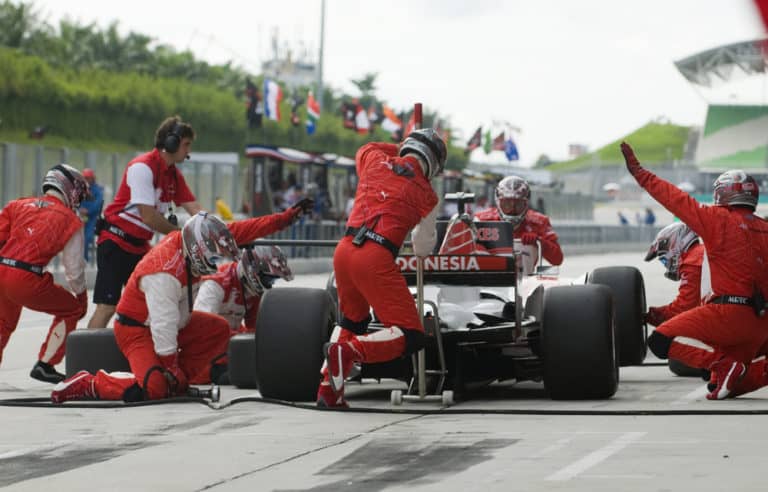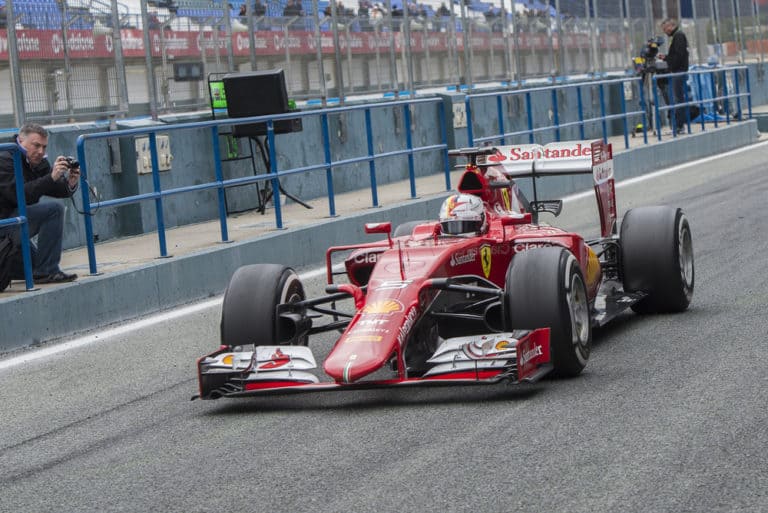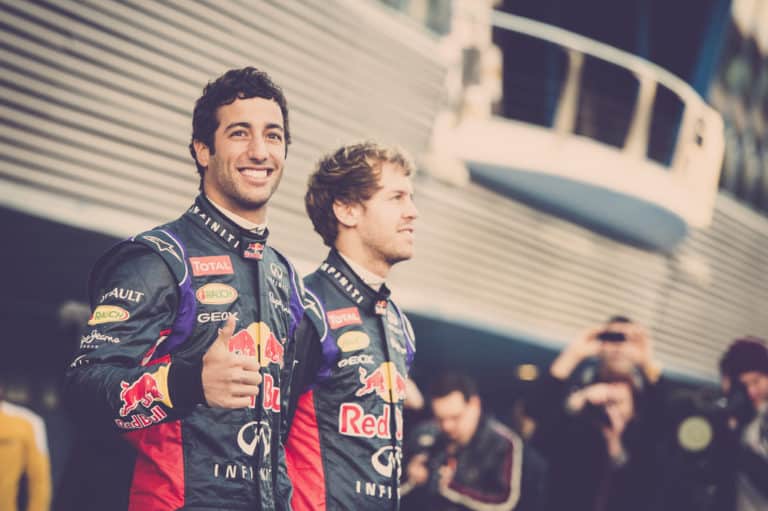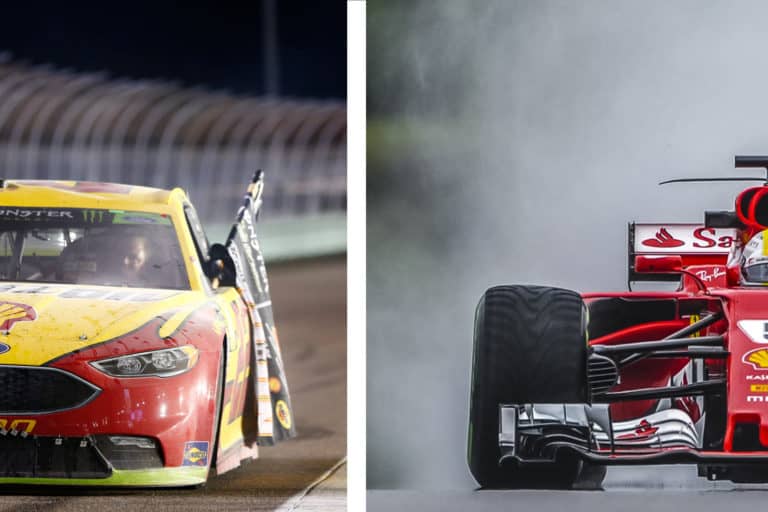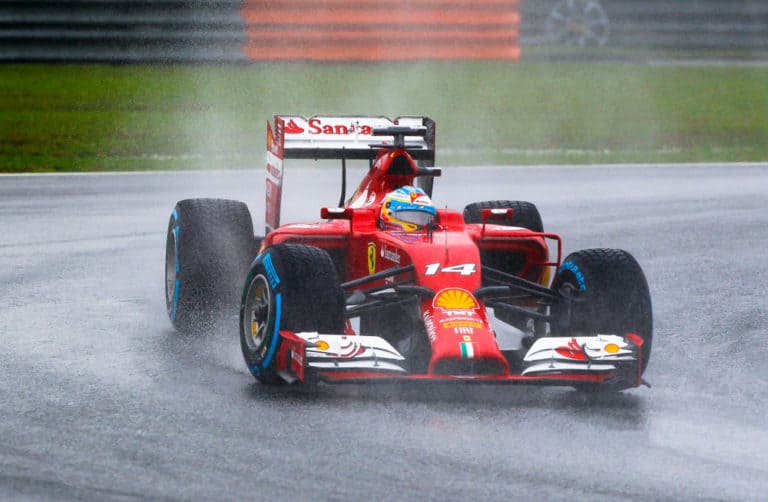Editorial credit: Natursports / Shutterstock.com
Formula One cars are designed to be one of the fastest racing car types across all racing disciplines. Not only can they go fast down a straight, but they are equally adept at slowing and cornering through the twisty bits in a way that no other racing car can match.
The gas consumption of a 2022 Formula One car is approximately 7,09 miles per gallon (39.85 liters/100km). Unfortunately, this is only an estimate as we do not know the impact of other factors such as altitude, the different track types, and how the aerodynamic setup affects gas consumption.
The gas consumption of Formula One cars has improved significantly from the earlier engine types, where the previous generation of F1 V8 engines achieved a gas consumption of only 3.8mpg (75 liters per 100 km).
If you’re looking for some F1 merchandise, check out the awesome stuff at the official F1 store here.
How Much Gas Does A F1 Car Use
Unfortunately, Formula One teams do not make their car’s Miles Per Gallon (MPG) figures available, and several assumptions must be made.
There are several other factors that we cannot include, such as.
- The effect altitude has on gas consumption.
- The effect the aerodynamic setup has on gas consumption
- The number of corners the drivers have to decelerate into and accelerate away from.
- The number and gradient of any hills the formula one car must climb up.
The factors we can work out, however, are.
- The gallons and liters that a Formula One car gas tank can carry.
- The maximum length a formula one car has to run in a single race.
The Quantity Of Gas Which A Formula One Car Can Carry
The maximum weight of the gas carried in a Formula One car is 105kg.
Assuming one gallon weighs 3.8 pounds (0.74kg)
The following list applies.
| Imperial | Metric | |
| Max fuel load in kgs | 105.00 | 105.00 |
| One gallon/liter of gas weighs | 3.80 pounds | 0.74 gallons |
| Gallons/liters in tank | 27.63 gallons | 141.89 liters |
The Maximum Distance A Formula One Car Has To Travel
The longest track on the 2022 Formula One circuit calendar is the Circuit Paul Ricard.
See below for the different track lengths and number of laps driven.
| Country | Track | Distance (km) | Distance (miles) | No of laps | Distance of race (miles) | Distance of race (km) |
| Monaco | Circuit de Monaco | 3.337 | 2.074 | 78 | 162 | 260 |
| Canada | Circuit Gilles Villeneuve | 4.361 | 2.710 | 70 | 190 | 305 |
| Mexico | Autódromo Hermanos Rodríguez | 4.304 | 2.674 | 71 | 190 | 306 |
| Brazil | Autódromo José Carlos Pace | 4.309 | 2.677 | 71 | 190 | 306 |
| Azerbaijan | Baku City Circuit | 6.003 | 3.730 | 51 | 190 | 306 |
| Australia | Albert Park Circuit | 5.279 | 3.280 | 58 | 190 | 306 |
| UAE (Abu Dhabi) | Yas Marina Circuit | 5.281 | 3.281 | 58 | 190 | 306 |
| United Kingdom | Silverstone Circuit | 5.891 | 3.661 | 52 | 190 | 306 |
| Austria | Red Bull Ring | 4.318 | 2.638 | 71 | 187 | 307 |
| Netherlands | Circuit Zandvoort | 4.259 | 2.646 | 72 | 191 | 307 |
| Hungary | Hungaroring | 4.381 | 2.722 | 70 | 191 | 307 |
| Italy (Monza) | Autodromo Nazionale Monza | 5.793 | 3.600 | 53 | 191 | 307 |
| Japan | Suzuka International Racing Course | 5.807 | 3.609 | 53 | 191 | 308 |
| Belgium | Circuit de Spa-Francorchamps | 7.004 | 4.352 | 44 | 191 | 308 |
| USA (Miami) | Miami International Autodrome | 5.41 | 3.360 | 57 | 192 | 308 |
| Bahrain | Bahrain International Circuit | 5.412 | 3.363 | 57 | 192 | 308 |
| Spain | Circuit de Barcelona-Catalunya | 4.675 | 2.905 | 66 | 192 | 309 |
| Saudi Arabia | Jeddah Corniche Circuit | 6.174 | 3.836 | 50 | 192 | 309 |
| USA (Austin) | Circuit of the Americas | 5.513 | 3.426 | 56 | 192 | 309 |
| Singapore | Marina Bay Street Circuit | 5.063 | 3.146 | 61 | 192 | 309 |
| Italy (Imola) | Autodromo Internazionale Enzo E Dino Ferrari | 4.909 | 3.05 | 63 | 192 | 309 |
| France | Circuit Paul Ricard | 5.842 | 3.63 | 53 | 192 | 310 |
Even though it has the fewest laps, the circuit length at Circuit Paul Ricard results in it being the longest race.
No refueling is allowed during a race; the teams must ensure sufficient gas to finish it, and sufficient left over to satisfy the marshals.
A typical formula for one race consists of the following.
- One slow formation lap of approximately 5.842 miles (Circuit Paul Ricard)
- Idling waiting for the grand Prix to start
- In-pit stops where the car needs to run the engine for an additional 25 seconds per stop.
- Assume there are two pit stops per race, each taking an additional 20 seconds per stop.
- The race is 192 miles long (Circuit Paul Ricard).
- One slow down, a victory lap of approximately 5.842 miles (Circuit Paul Ricard)
The result is that the car will travel 195.84 miles in a race.
The teams run the Formula One car as tanks as light as possible, and assuming they aim to have a one-lap margin left at the end of the race, the formula one car will travel 196.85 miles (say 198 miles) at the longest race of the season as the Circuit Paul Ricard.
If this racetrack requires a full load of 105kg and the tank is filled for this race, the car uses 27.63 gallons.
Therefore, we can assume that the MPG of an F1 Car is 7,09 miles per gallon (39.85 liters/100km).
Unfortunately, this is only an estimate as it does not account for the variables we do not know.
The Factors Which Affect A Formula One Car Design?
Formula One cars’ primary function and purpose have remained unchanged since the first F1 race at Silverstone in the United Kingdom in 1950.
They are designed to travel at high AVERAGE speeds around complex formula One racetracks worldwide. To achieve the necessary track times in such varied conditions, they must be engineered to precise tolerances while allowing for significant changes to their setup profiles for the different tracks.
In the last decade, Formula One world has been required to embrace technologies that make the cars more environmentally friendly and reduce the sports carbon footprint by substantive degrees.
It has necessitated a change in the methods used by the engines to generate the power required, which in turn has positively impacted the Formula One cars’ fuel consumption figures.
It has resulted in the latest era of Formula One car engines incorporating greener technology which involves the following measures.
- Reducing engine size from V8 to V6 units.
- Using regenerative power systems such as the MGU-H and MGU-K.
- Switching to larger wheels for the 2022 season.
- Aerodynamic improvements (although the main intention is to achieve higher performance, handling, and following distance to the car in front).
- Using a 10% gas/ethanol blend for the 2022 season.
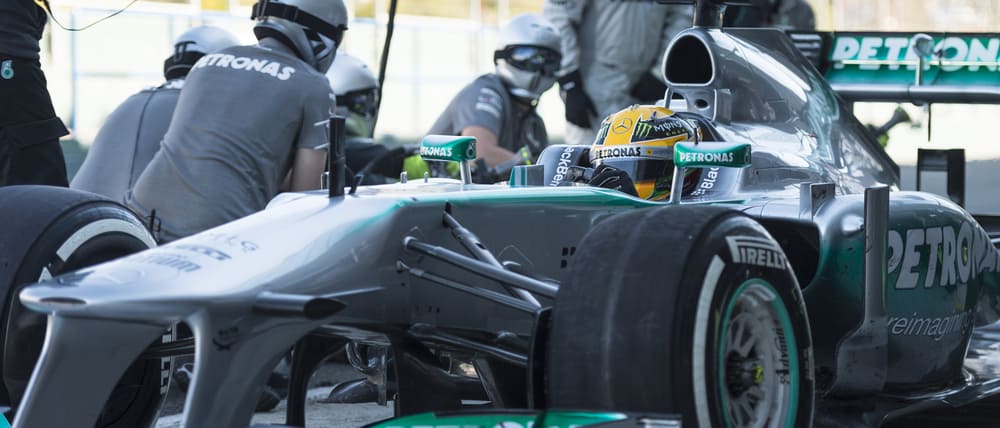
Conclusion
In an ideal world, Formula One would not have to be concerned about the gas consumption of the cars. Unfortunately, with the intense focus on carbon emissions and renewable fuels, the sport has had to ensure that the cars align with the environmental issues.
The current gas consumption of 7 mpg may sound high by private car standards; however, considering how this has improved over the years, it is a commendable number.


